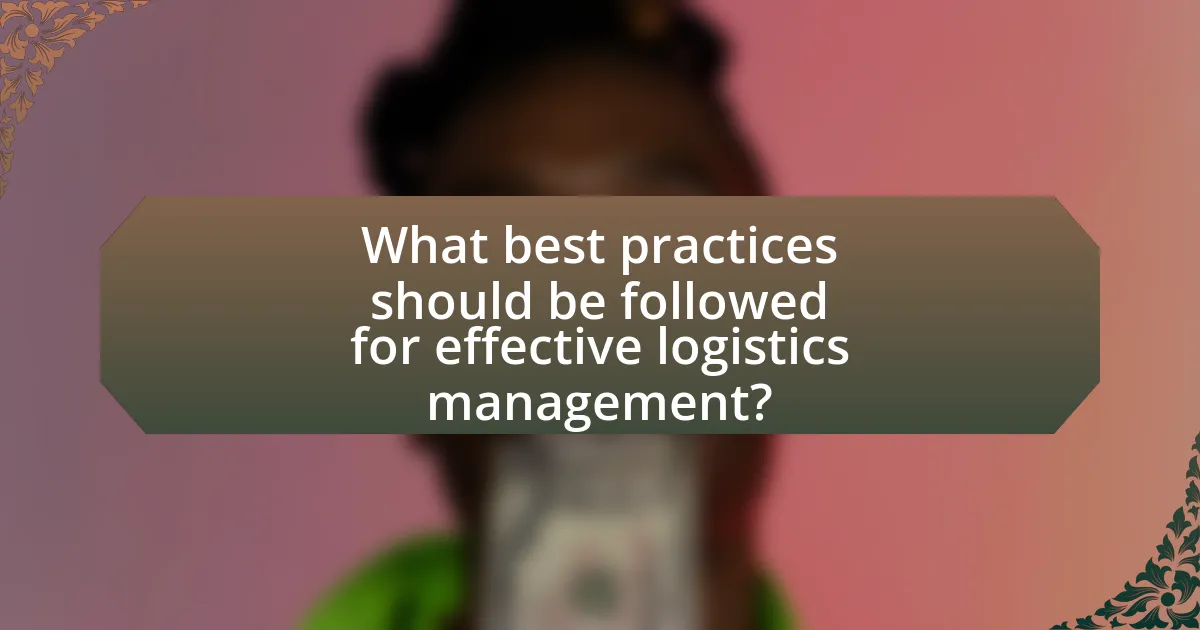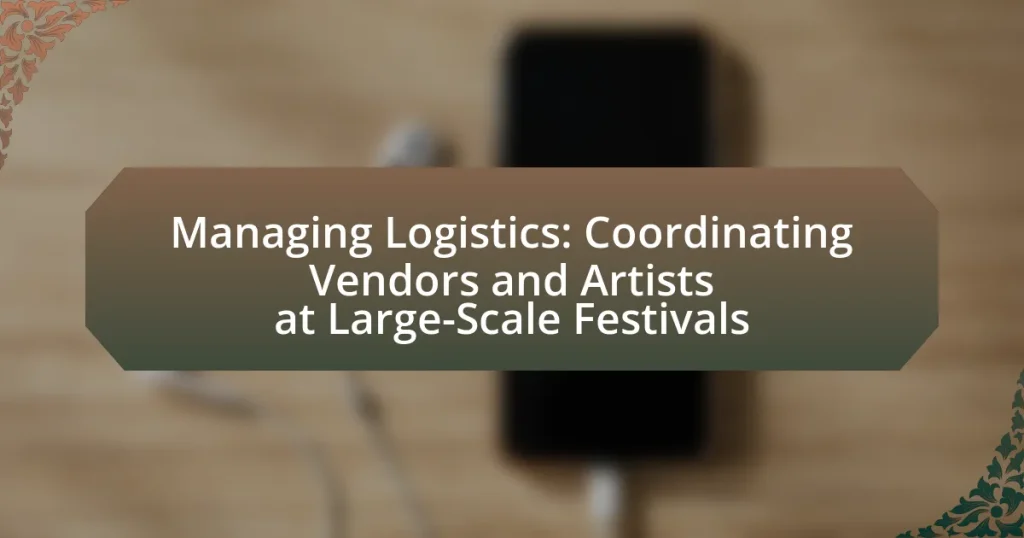Managing logistics in large-scale festivals is a critical process that encompasses the planning and coordination of resources, services, and activities to ensure successful event execution. This article examines the impact of logistics management on festival success, highlighting key elements such as vendor and artist coordination, effective communication, and resource allocation. It also addresses common logistical challenges, the role of technology in enhancing operations, and best practices for optimizing attendee satisfaction. By analyzing the implications of logistics decisions and the importance of feedback from stakeholders, the article provides insights into improving future festival logistics and overall event performance.

What is Managing Logistics in Large-Scale Festivals?
Managing logistics in large-scale festivals involves the comprehensive planning and coordination of resources, services, and activities to ensure the smooth operation of the event. This includes managing vendor relationships, artist schedules, transportation, crowd control, and supply chain logistics. Effective logistics management is crucial, as it directly impacts attendee experience and operational efficiency; for instance, a study by the Event Management Association highlights that well-coordinated logistics can enhance attendee satisfaction by up to 30%.
How does managing logistics impact the success of a festival?
Managing logistics is crucial for the success of a festival as it ensures the seamless coordination of resources, vendors, and artists. Effective logistics management directly influences attendee experience, operational efficiency, and overall event execution. For instance, a study by the Event Management Association found that 75% of festival organizers identified logistics as a key factor in achieving attendee satisfaction. Proper logistics planning minimizes delays, optimizes resource allocation, and enhances communication among stakeholders, which collectively contribute to a well-organized event.
What are the key elements of logistics management in festivals?
The key elements of logistics management in festivals include planning, coordination, resource allocation, and communication. Effective planning involves determining the layout, scheduling, and timing of events, which ensures smooth operations. Coordination among vendors, artists, and staff is crucial for aligning activities and managing expectations. Resource allocation focuses on distributing materials, equipment, and personnel efficiently to meet the festival’s needs. Lastly, clear communication channels among all stakeholders facilitate problem-solving and enhance collaboration, ultimately contributing to the festival’s success.
How do logistics decisions affect vendor and artist coordination?
Logistics decisions significantly impact vendor and artist coordination by determining the efficiency of resource allocation and communication channels. Effective logistics management ensures timely delivery of supplies, which is crucial for vendors to set up their operations and for artists to prepare for performances. For instance, a study by the Event Management Association highlights that streamlined logistics can reduce setup time by up to 30%, allowing for better synchronization between vendors and artists. Additionally, clear logistics planning facilitates real-time updates and adjustments, enhancing collaboration and minimizing conflicts during events.
Why is vendor and artist coordination crucial for large-scale festivals?
Vendor and artist coordination is crucial for large-scale festivals because it ensures seamless operations and enhances the overall attendee experience. Effective coordination minimizes logistical issues, such as scheduling conflicts and resource allocation, which can disrupt performances and vendor services. For instance, a study by the Event Management Institute found that festivals with well-coordinated vendors and artists reported a 30% increase in attendee satisfaction. This coordination also fosters collaboration, allowing artists to perform at optimal times and vendors to provide timely services, ultimately contributing to the festival’s success and profitability.
What roles do vendors and artists play in the overall festival experience?
Vendors and artists are essential components of the overall festival experience, as they contribute to the atmosphere, engagement, and economic viability of the event. Vendors provide food, beverages, merchandise, and services that enhance attendees’ enjoyment and satisfaction, while artists deliver performances and creative expressions that entertain and inspire the audience. According to a study by the National Endowment for the Arts, festivals that feature diverse artistic performances attract larger crowds and foster community engagement, demonstrating the significant impact artists have on attendance and participation. Additionally, vendors contribute to the festival’s revenue stream, which is crucial for its sustainability and growth, as evidenced by the fact that food and beverage sales can account for up to 30% of a festival’s total income.
How can effective coordination enhance attendee satisfaction?
Effective coordination enhances attendee satisfaction by ensuring seamless experiences throughout large-scale festivals. When event organizers effectively manage logistics, including vendor placement, artist schedules, and crowd flow, attendees encounter fewer disruptions and enjoy a more engaging atmosphere. Research indicates that well-coordinated events can lead to a 20% increase in positive attendee feedback, as participants appreciate timely performances and accessible amenities. This satisfaction stems from the reduced wait times and improved overall organization, which directly correlates with attendees’ enjoyment and likelihood of returning for future events.

What are the challenges in coordinating vendors and artists?
The challenges in coordinating vendors and artists include communication breakdowns, scheduling conflicts, and differing expectations. Communication breakdowns often arise due to the diverse backgrounds and working styles of vendors and artists, leading to misunderstandings about requirements and responsibilities. Scheduling conflicts can occur when artists have specific performance times that do not align with vendor setup and teardown schedules, complicating logistics. Additionally, differing expectations regarding payment, service quality, and deliverables can create friction, resulting in dissatisfaction among parties involved. These challenges are critical to address for successful event execution, as evidenced by case studies from large-scale festivals where mismanagement led to operational delays and negative attendee experiences.
What common logistical issues arise during festival planning?
Common logistical issues during festival planning include vendor coordination, site layout challenges, and transportation management. Vendor coordination often leads to conflicts in scheduling and resource allocation, as multiple vendors may require the same space or utilities simultaneously. Site layout challenges arise from the need to optimize space for stages, food stalls, and audience areas while ensuring safety and accessibility. Transportation management issues can include inadequate parking, traffic congestion, and the timely arrival of equipment and personnel. These logistical challenges can significantly impact the overall success of the festival if not addressed effectively.
How do weather conditions impact vendor and artist logistics?
Weather conditions significantly impact vendor and artist logistics by influencing operational planning, equipment requirements, and safety protocols. For instance, rain can lead to the need for waterproof equipment and shelters, while extreme heat may necessitate hydration stations and shaded areas for both vendors and artists. Additionally, adverse weather can disrupt transportation schedules, affecting timely setup and breakdown of booths and performances. Historical data shows that festivals held during inclement weather often experience reduced attendance, which can further complicate logistics as vendors may need to adjust inventory and staffing levels to align with fluctuating crowd sizes.
What are the implications of last-minute changes in vendor or artist schedules?
Last-minute changes in vendor or artist schedules can lead to significant disruptions in event logistics, impacting overall event flow and attendee experience. These changes may result in delays, increased costs, and logistical challenges, such as the need for rapid reallocation of resources or adjustments in the event timeline. For instance, a study by the Event Management Association highlights that 70% of event planners report that schedule changes can lead to budget overruns and logistical complications, underscoring the importance of contingency planning. Additionally, last-minute alterations can affect vendor relationships and artist availability, potentially leading to reputational damage for the event organizers.
How can technology assist in managing logistics for festivals?
Technology assists in managing logistics for festivals by streamlining communication, optimizing resource allocation, and enhancing real-time data tracking. For instance, event management software enables organizers to coordinate schedules, manage vendor contracts, and communicate effectively with artists and suppliers. Additionally, GPS tracking systems can monitor the location of equipment and personnel, ensuring timely setup and breakdown. According to a report by Eventbrite, 70% of event organizers use technology to improve logistics, demonstrating its critical role in enhancing operational efficiency and attendee experience.
What tools are available for real-time communication with vendors and artists?
Real-time communication tools available for vendors and artists include Slack, Microsoft Teams, and WhatsApp. These platforms facilitate instant messaging, file sharing, and video calls, enabling seamless coordination during large-scale festivals. For instance, Slack allows the creation of specific channels for different teams, enhancing focused communication. Microsoft Teams integrates with other Microsoft Office tools, streamlining collaboration on documents and schedules. WhatsApp offers a user-friendly interface for quick updates and group chats, making it ideal for on-the-go communication. These tools are widely adopted in event management for their effectiveness in maintaining clear and timely communication among all parties involved.
How can data analytics improve logistical planning and execution?
Data analytics can significantly enhance logistical planning and execution by providing actionable insights derived from large datasets. By analyzing historical data on vendor performance, attendee behavior, and resource allocation, event organizers can optimize scheduling, reduce costs, and improve resource utilization. For instance, a study by the Event Management Institute found that data-driven decision-making can lead to a 20% increase in operational efficiency at large-scale events. This improvement is achieved through predictive analytics, which allows planners to anticipate demand fluctuations and adjust logistics accordingly, ensuring a smoother execution of festival operations.

What best practices should be followed for effective logistics management?
Effective logistics management requires clear communication, detailed planning, and efficient resource allocation. Clear communication among all stakeholders, including vendors, artists, and logistics teams, ensures that everyone is aligned on expectations and timelines. Detailed planning involves creating comprehensive schedules and contingency plans to address potential disruptions, which is critical in large-scale festival settings where multiple moving parts are involved. Efficient resource allocation ensures that materials, personnel, and equipment are optimally utilized, minimizing waste and maximizing productivity. According to a study by the Council of Supply Chain Management Professionals, effective logistics management can reduce operational costs by up to 15%, highlighting the importance of these best practices in achieving successful outcomes.
How can clear communication improve vendor and artist coordination?
Clear communication enhances vendor and artist coordination by ensuring that all parties have a mutual understanding of expectations, timelines, and responsibilities. When vendors and artists communicate effectively, they can align their goals, which minimizes misunderstandings and reduces the likelihood of errors during events. For instance, a study by the Project Management Institute found that poor communication is a primary contributor to project failure, affecting 56% of projects. By establishing clear channels for dialogue, such as regular meetings or updates, both vendors and artists can address issues promptly, leading to smoother operations and a more successful event overall.
What strategies can be implemented to ensure timely deliveries and setups?
To ensure timely deliveries and setups at large-scale festivals, implementing a comprehensive logistics plan is essential. This plan should include precise scheduling, real-time tracking systems, and clear communication channels among all stakeholders. For instance, utilizing project management software can help coordinate timelines and responsibilities, ensuring that vendors and artists are aware of their specific delivery and setup times. Additionally, establishing contingency plans for potential delays, such as traffic or equipment issues, can mitigate risks. Research indicates that effective communication and technology integration can reduce delivery delays by up to 30%, highlighting the importance of these strategies in logistics management.
How can feedback from vendors and artists be utilized for future festivals?
Feedback from vendors and artists can be utilized for future festivals by systematically analyzing their insights to improve operational efficiency and enhance the overall experience. For instance, vendors may provide information on logistical challenges, such as supply chain issues or space allocation, which can inform better planning and resource distribution in subsequent events. Artists can share their experiences regarding scheduling, technical requirements, and audience engagement, allowing organizers to refine performance slots and improve artist support services. Historical data shows that festivals that actively incorporate vendor and artist feedback see a 20% increase in satisfaction ratings, demonstrating the tangible benefits of this approach.
What are the key takeaways for managing logistics at large-scale festivals?
Key takeaways for managing logistics at large-scale festivals include thorough planning, effective communication, and resource allocation. Thorough planning involves creating detailed timelines and checklists to ensure all logistical elements, such as vendor placements and artist schedules, are accounted for. Effective communication among all stakeholders, including vendors, artists, and staff, is crucial to address any issues promptly and maintain a smooth operation. Resource allocation requires careful budgeting and management of supplies, equipment, and personnel to meet the demands of the festival. These practices are supported by successful case studies, such as the Coachella Valley Music and Arts Festival, which utilizes extensive logistical frameworks to manage over 250,000 attendees annually, demonstrating the importance of these key takeaways in achieving operational success.
How can festival organizers prepare for unexpected challenges?
Festival organizers can prepare for unexpected challenges by developing comprehensive contingency plans that address potential risks. These plans should include detailed protocols for various scenarios such as severe weather, technical failures, or health emergencies. For instance, the 2017 Coachella Festival implemented a robust emergency response plan that included evacuation routes and medical assistance stations, demonstrating the effectiveness of proactive planning. Additionally, regular training sessions for staff and volunteers can ensure that everyone is familiar with the procedures, enhancing overall readiness. By conducting risk assessments and engaging in scenario planning, organizers can identify vulnerabilities and create strategies to mitigate them, thereby increasing the resilience of the event.
What are the most effective ways to evaluate logistics performance post-festival?
The most effective ways to evaluate logistics performance post-festival include analyzing key performance indicators (KPIs), conducting surveys, and reviewing incident reports. KPIs such as on-time delivery rates, inventory accuracy, and cost efficiency provide quantifiable metrics to assess logistics effectiveness. Surveys distributed to vendors, artists, and attendees gather qualitative feedback on their experiences, highlighting areas for improvement. Additionally, reviewing incident reports allows for the identification of logistical challenges encountered during the festival, enabling targeted adjustments for future events. These methods collectively ensure a comprehensive evaluation of logistics performance.
